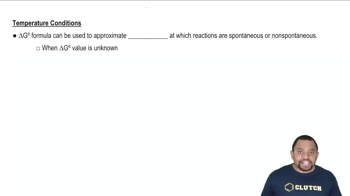Standard Free-Energy Change (∆G°)
The standard free-energy change (∆G°) of a reaction is a thermodynamic quantity that indicates the spontaneity of a reaction under standard conditions (1 bar pressure, 1 M concentration, and a specified temperature, usually 25°C). A negative ∆G° value suggests that the reaction is spontaneous, while a positive value indicates non-spontaneity. It is calculated using the Gibbs free energy equation, which relates enthalpy, entropy, and temperature.
Recommended video:
Standard Gibbs Free Energy and Temperature
Standard Free Energy of Formation (∆G°f)
The standard free energy of formation (∆G°f) of a substance is the change in free energy when one mole of a compound is formed from its elements in their standard states. This value is crucial for calculating the overall free energy change of a reaction using Hess's law. The standard free energy of formation for elements in their most stable form is defined as zero, providing a reference point for other compounds.
Recommended video:
Standard Gibbs Free Energy and Temperature
Relationship Between ∆G° and Reaction Spontaneity
The relationship between standard free-energy change (∆G°) and reaction spontaneity is fundamental in thermodynamics. A negative ∆G° indicates that the reaction can proceed spontaneously in the forward direction, while a positive ∆G° suggests that the reverse reaction is favored. This relationship helps predict the direction of chemical reactions and is essential for understanding equilibrium and reaction mechanisms.
Recommended video:
Relationship between ∆E°, ∆G°, and K
 McMurry 8th Edition
McMurry 8th Edition Ch.18 - Thermodynamics: Entropy, Free Energy & Equilibrium
Ch.18 - Thermodynamics: Entropy, Free Energy & Equilibrium Problem 92
Problem 92 Verified step by step guidance
Verified step by step guidance

